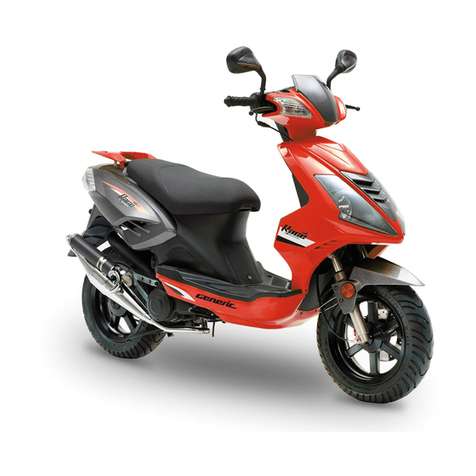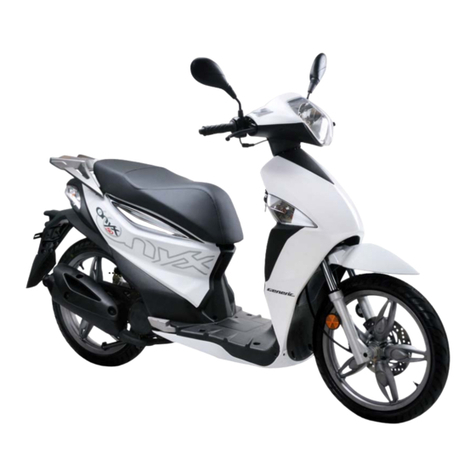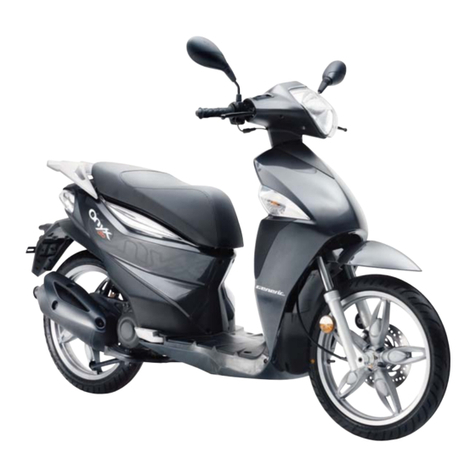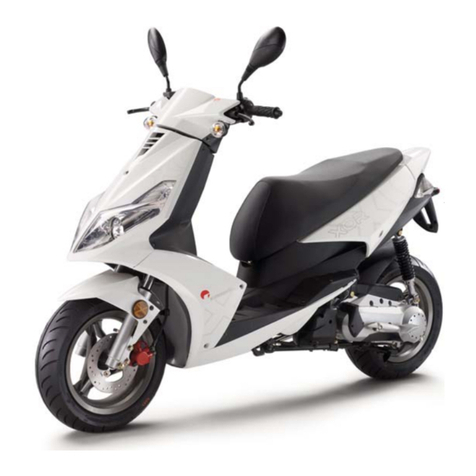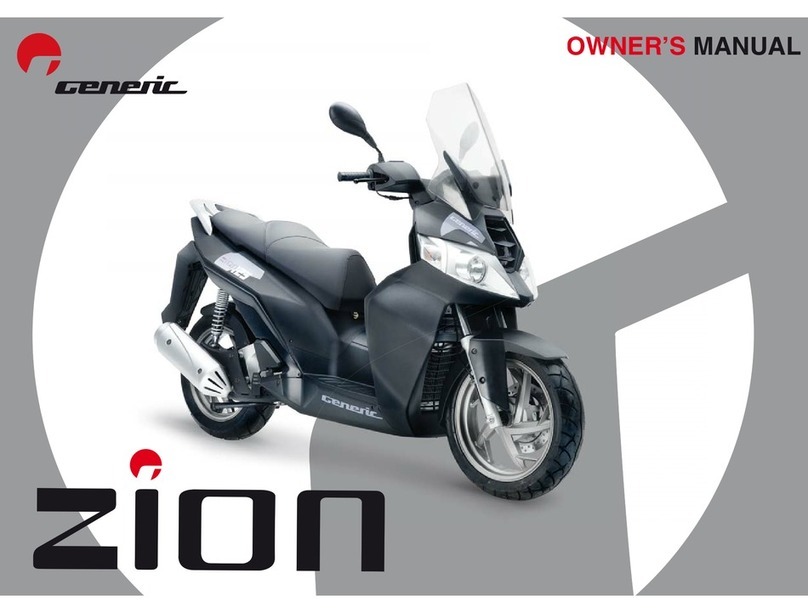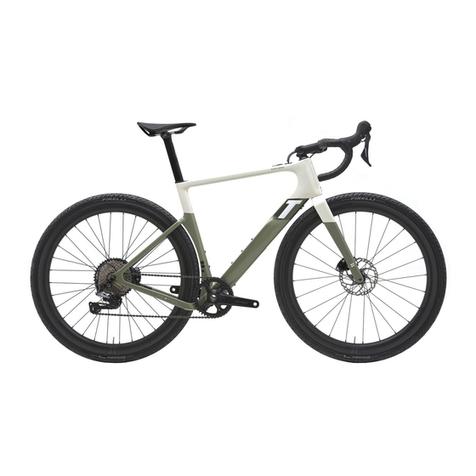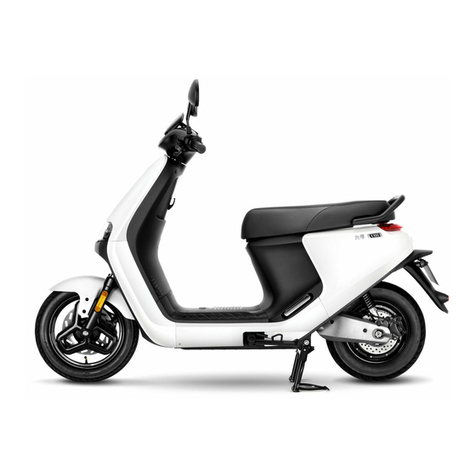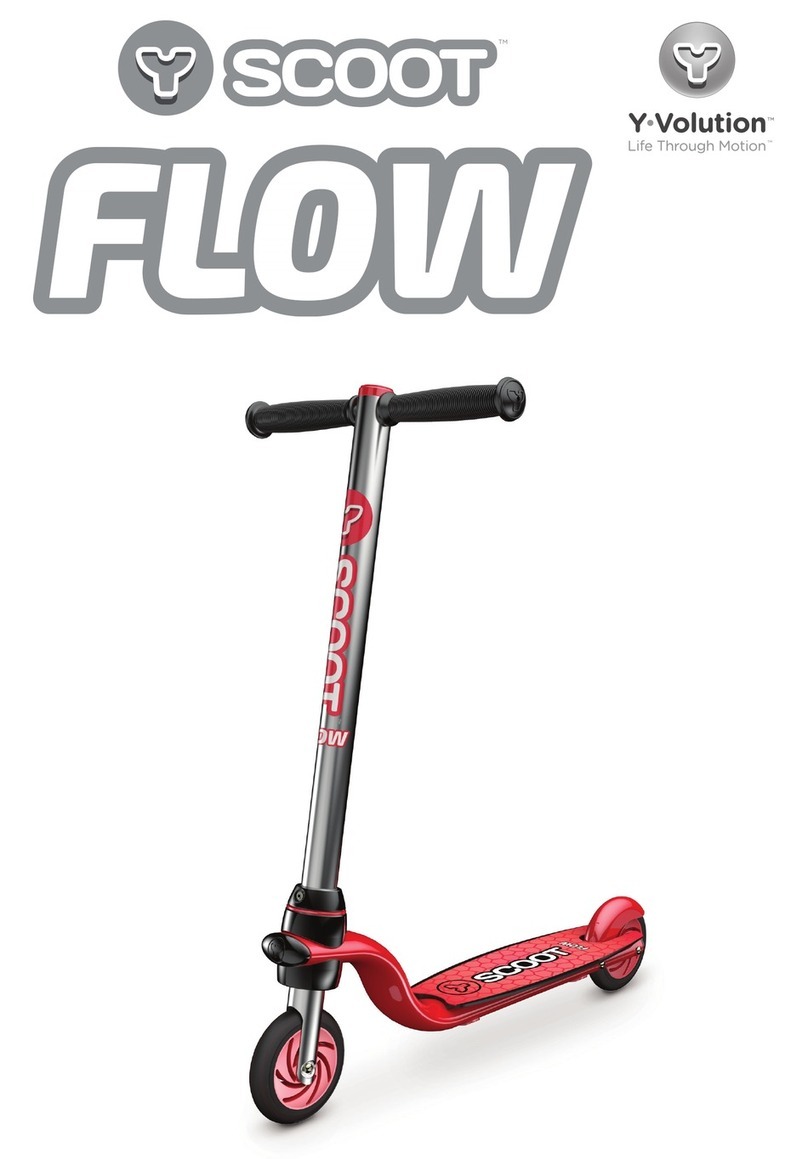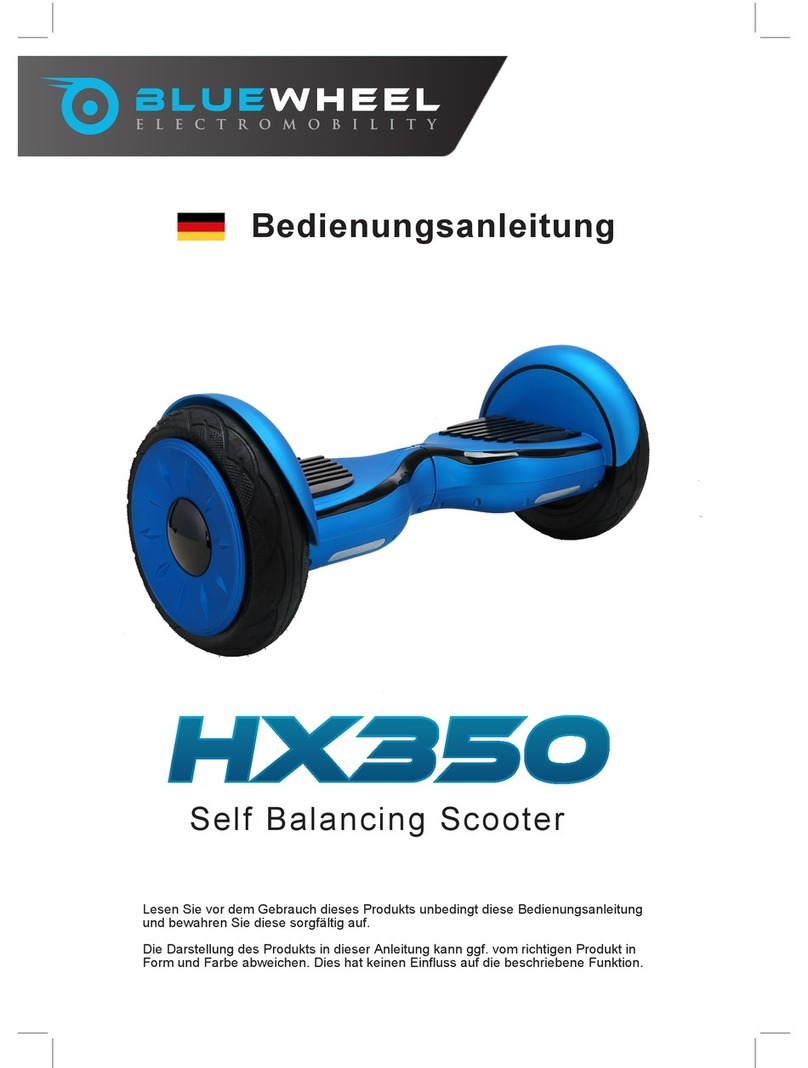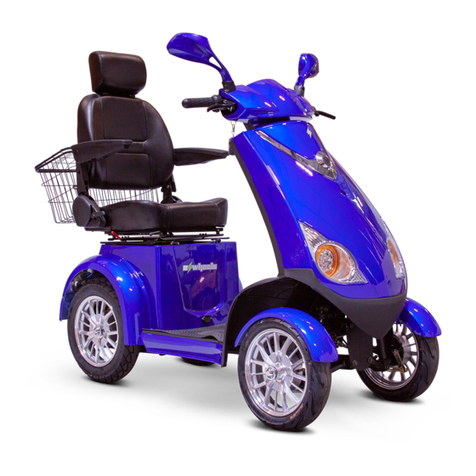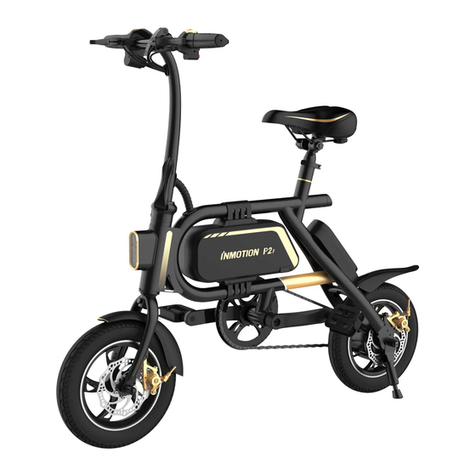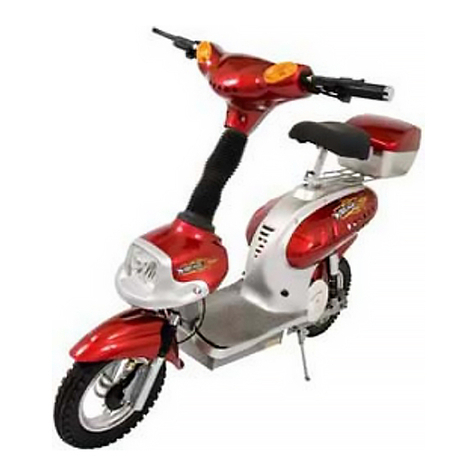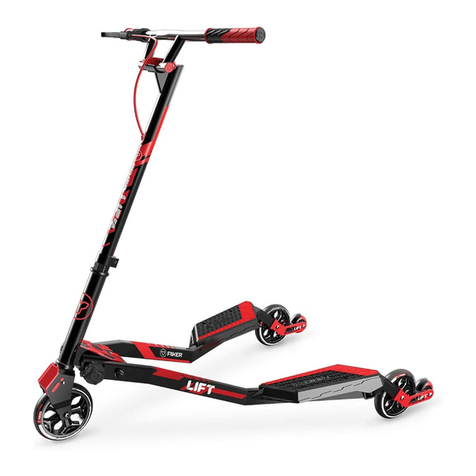Generic Ideo 50 User manual

Ideo 50
Type FCC
Reservedele
Holtvej 8-10, Høruphav, 6470 Sydals
Telefon: +45 73 15 11 00
Fax: +45 73 15 11 01
info@scanmi.dk · www.scanmi.dk
CVR: 27 73 31 07
www.genericmotor.dk
Juli 2011

CONTENTS
1. Before Riding.................................................................................................................................................1
2. Safety Riding..................................................................................................................................................1
3. Riding Tips.....................................................................................................................................................2
4. Use Genuine Spare Parts ..........................................................................................................................3
5. Use of Each Component...........................................................................................................................3
Gauges......................................................................................................................................................3
Operation of Ignition Switch...................................................................................................................5
Use of Buttons.........................................................................................................................................5
Saddle Lock...............................................................................................................................................7
Storage Box ..............................................................................................................................................7
Fuel Tank Cap...........................................................................................................................................7
Brake .........................................................................................................................................................8
Parking Method.......................................................................................................................................8
6. Important Points and Cautions for Starting Engine...............................................................................9
7. The Best Way to Drive off.........................................................................................................................10
The Control of Throttle Valve Handle..................................................................................................10
8. Inspection and Maintenance before Riding...........................................................................................10
Routine Inspection.................................................................................................................................10
Inspection and Replenishment of Engine Oil .................................................................................... 11
Inspection of Fuel Level ........................................................................................................................ 11
Transmission Oil Inspection..................................................................................................................12
Inspection and Adjustment of Brake Free Play ................................................................................12
Disc Brake Inspection [Depending on Models]................................................................................13
Throttle Valve Handle Clearance Adjustment...................................................................................14
Inspection and Maintenance of Battery.............................................................................................14
Tire Inspection ........................................................................................................................................15
Steering Handle Front Shock Absorbers Inspection .....................................................................16
Checking and Changing Fuses .........................................................................................................16
Checking the Turn Signal Lights and Horn ......................................................................................17
Checking the Front and Rear Lights .................................................................................................17
Checking the Brake Light ...................................................................................................................17
Checking for Fuel Leakage ................................................................................................................17
Checking the Lubrication of Body’s Various Mechanisms ...........................................................17
Checking the Spark Plug ....................................................................................................................18
Checking the Air Cleaner ....................................................................................................................18
9. When there is an Abnormal Condition or a Trouble ...........................................................................19
Diagnosis when Engine does not Start ............................................................................................19
INDEX.................................................................................................................................................................25

1
1. BEFORE RIDING
This manual describes the correct usage of this motorcycle including safety riding, simple inspection
methods and so on.
For a more comfortable and safety riding, please read this manual carefully.
Thank you very much for your trust in our product
In order to maximize your motorcycle’s performance, a periodical inspection and maintenance
should be completely carried out. We recommend that after riding your new motorcycle for the first
500 kilometers, you should take your motorcycle to the original dealer for an initial inspection.
Please notice that you loose the warranty rights if you miss the inspections.
zIn case the motorcycle’s specifications and construction are modified and different from the photos
and diagrams on the owner’s manual/catalogues, the specifications and construction of the actual
motorcycle shall prevail.
2. SAFE RIDING
It is very important to be relaxed and clothe properly when driving, observe traffic regulations, do not
rush, always drive carefully and relaxed.
Usually, most people would ride their newly bought motorcycle very carefully, but after they became
familiar with their motorcycles, they tended to become reckless which may result in an accident.
To remind you:
zPlease wear a safety helmet, and properly tighten the chin belt when riding a motorcycle.
zClothes with open or loose cuffs may be blown by wind and cause the cuffs to get caught on the
steering handle and thus affects riding safety. So, put on clothes with tight sleeves.
zHold the steering handle by both hands when riding. Never ride with only one hand.
zObserve the speed limit.
zPerform periodical maintenance and inspection in accordance with the schedule.
WARNING!!
zTo avoid getting burned by exhaust pipe when taking a passenger. Make sure your passenger has
put his/her feet on the pedals.
zAfter running, the exhaust pipe is very hot, be careful not to get burned when conducting an
inspection or maintenance.
zAfter running, the exhaust pipe is very hot; select a suitable location to park your motorcycle to
avoid others getting burned by the exhaust pipe.

2
CAUTION:
Modified motorcycle will affect its structure or performance, and cause poor engine operation or
exhaust noise, which will result in shortening the motorcycle’s service life. Besides, modification is
illegal and does not conform to the original design and specifications. A modified motorcycle will not
be covered by warranty. Therefore, do not modify your motorcycle at will.
3. RIDING TIPS
zKeep the related parts of your body such as arms, palms, lumbar, and toes relax and ride with
the most comfortable posture in order to be able to react quickly whenever it is necessary.
zRider’s postures will great influent riding safety. As for the riding position, please always keep
your body’s gravity on the center of seat. If your body’s gravity is placed on the rear of seat, the
front wheel load will be reduced; this can cause steering handles shaking. Riding in this way is
dangerous.
zIt will be much easier to make a turn if rider inclines his body inward when turning. On the other
hand, the rider will feel unstable if his body and the motorcycle do not incline.
zOn bumpy, unleveled and slope road, the road condition may change very often. Driving on
these roads may become very unstable. To drive safely and smoothly, know your road
condition before hand, slow down, and hold the handle firmly with aid of your shoulder.
zSuggestion: Do not load objects on the front pedals unnecessarily, to avoid affecting the riding
safety and the operation of steering handle.
CAUTION:
Feeling on the handle is different when the vehicle is with load or without load. Overload will make
steering handle swing and then influent riding safety. Thus, please be ware of load weight.
CAUTION:
zPlease do not load cargo or luggage on places where are not designed for loading to prevent
danger and damage.
zDo not place rags or similar objects between the storage compartment and engine to avoid
engine seizure because of inadequate engine oil supply.
SUGGESTION
To maximize the motorcycle’s performance and prolong its service life:
The first month or first 500km is the wear- in period for the engine and components. Avoid rapid
acceleration and top speed on a long distance.

3
4. USE GENUINE SPARE PARTS
In order to maintain the motorcycle’s best performance, each part’s quality, material, and machined
precision must conform to the design requirements. “GENERIC Spare Parts” were made from the
same high quality materials used for the original motorcycle. No parts would be sold to the market until
they could meet the designed specifications through sophisticated engineering and stringent quality
control. Therefore, it is necessary to purchase “GENERIC Spare Parts” from “GENERIC Authorized
Dealers” when replacing spare parts. If you buy cheap or fake substitute parts from the market, no
guarantee can be provided either for the quality or durability. Also, it may result in unexpected troubles
and lower the motorcycle’s performance.
5. USE OF EACH COMPONENT
Gauges
Symbol picture of instruments!
CAUTION:
Do not wipe plastic components, e.g. instrument panel, headlight,
with organic solvents such as gasoline…etc to avoid damaging
these components.
1. Fuel Gauge
The pointer in this gauge shows how much fuel remains in the
tank.
The pointer stays in “E” position when key switch is turned to
“OFF.”
When key switch is turned to “ON” position and the “pointer”
also in “E” position refill the fuel tank immediately.
Turn signal indicator (yellow)
Fuel gauge
Oil warnin
g
li
g
ht
(
red
)
High beam signal lamp (blue)
Speedometer
Odometer
1. Rear light
2. Rear Handhold
3. Helmet box
4. Seat
5. Helmet hook
6. Rear Mirror
7. Brake handle
8. Headlight
9. Disc Break
10. Side Stand
11. Passenger Footrest
12. Main Stand
13. Engine
14. Rear Shock Absorber

4
2. Turn Signal Indicator
The left or right Indicator will be flashing according to the operated directions of turn signal light
switch when it is turned on.
3. High Beam Indicator
This indicator comes on with high beam headlight is turned on.
4. Engine Oil Warning Light
Turn the main switch to the “ON” position, if the oil warning light comes on continuously, this
indicates the engine oil level is too low, add oil as required.
WARNING:
zTo continue drive the vehicle under low oil level condition will result in engine damage due to lack
of lubrication of engine parts. It is therefore very important to bring your vehicle to your dealer for
oil replenishment immediately whenever the warning light comes on continuously.
zUse only 2-cycle engine oil with the required specifications of manufacturer. Otherwise, this
company will not assume any responsibility for damages resulted from using substandard engine
oil.
Recommended oil: Castrol Power 1 Racing
5. Speedometer
This shows your speed in kilometers per hour and
miles per hour.(km/h and mph).
6. Odometer
This odometer shows the total kilometers this vehicle
has been driven.
CAUTION:
Observe the speed limit to ensure
drive safety.

5
OPERATION OF IGNITION SWITCH
ON “Start” position
zEngine can be started in this position.
zIgnition switch key can not be removed.
OFF “Stop” position
zEngine is shut off and can not be started in this position.
zIgnition switch key can be removed.
LOCK “Lock”position
zTurn the handle all the way to left, then press down the
key and turn the key to the “LOCK” position on the left.
zIn this position, the handle is locked and the key can be
removed.
zTo unlock, simply turn the key from “LOCK” to “OFF”.
CAUTION:
zNever operate the ignition switch key when the motorcycle is running. To turn the ignition
switch to “OFF” and “LOCK,” will shut off the electrical system and that may result in a dangerous
accident. Therefore, the ignition switch can only be turned off after the motorcycle has been
completely stopped.
zAlways remove the key and be sure to take the key away with you after locking the steering
handle before leaving your motorcycle.
zIf ignition switch remains in the “ON” position for a prolonged period after the engine has been
stopped, the battery’s capacity will be reduced and this may affect the engine’s start ability.
USE OF BUTTONS
High beam changing switch
Turn signal switch
Horn switch
Headlight switch
Start button
Symbol pictures for explanatory purposes used above!
Ignition Switch

6
zLight Switches
When the switch is turned to this position, headlight, rear light, instrument panel light, and
position light will go on.
When the switch is turned to this position, rear light, instrument panel light, and position light
will go on.
When the switch is turned to this position, all lights will go off. (Depending on Models)
zElectrical Starter Button
This is the electrical starter button. It is used for starting the engine.
When the ignition switch key turns to “ON” and brake lever hold, and then press this
button down to start engine. This mechanism is designed for safety. Thus, the front or
rear brake lever must be hold before using this button so that engine can be started.
CAUTION:
zRelease this button immediately after engine has been started. Never press the button again
during the engine is running. This could lead to seriously defects on the engine.
zDo not use light system during starting the engine. Turn headlight and turn signal lights to the
“OFF” position when the engine is being started.
zHigh/Low Beam Switch
This is the high and low beam of headlight switching switch. Press this switch to switch between
high and low beams.
This is for high beam.
This is for low beam. (Please turn to low beam when riding in city)
zTurn Signal Switch
Turn signal lights are used when turning left/right or changing lane.
Turn ignition switch to “ON”, and slide the turn signal switch to left or right. Then, the turn signal lights
will flash. If you press the middle of the switch the indicator will turn off.
Right-side turn signal light flashing means you intend to make a right turn.
Left-side turn signal light flashing means you intend to make a left turn.
zHorn Switch
Press this button down when ignition switch is in the “ON” position, the horn will sound.
CAUTION:
zDo not press this button when you are in the no horn area.

7
SADDLE LOCK
zUnlock:
Insert ignition switch key into the lock on the lower left
of the saddle, and turn the key to the right. Then, the
saddle can be lifted up.
zLock:
Press the saddle down and it will be locked
automatically.
PASSENGER FOOTREST
•Press the passenger footrest and they will automatic
open.
Please take care about the maximum Load of the rear
footrest. 30kg on each side.
STORAGE BOX
zThis box is located under the saddle.
zMaximum load capacity: 10kg.
zDo not store valuables in the box.
zPlease make sure that seat cushion had been
locked completely after it was down.
zTake out valuables before washing to avoid
wetting these objects.
zDo not place thermal sensitive objects in the
box because of engine’s heat and high
temperature inside.
FUEL TANK CAP
1. Insert ignition switch key into the lock on the fuel tank cap, and turn the key to the right, then the
cap can be removed.
2. Do not fill above the fuel upper limit when refueling.
3. To lock the fuel tank please specially take care that the mark on the cap fits to the mark on the
vehicle and press down the cap in parallel until a “click” sound is heard. That means the cap is
locked (the ignition key now turns back to the left slightly). To remove the ignition key, simply turn
the key to the left and then remove it.
WARNING:
zMain stand should be put down on the ground, engine should be shut off and flames should be
strictly prohibited to ensure safety when refuelling.
zDo not fill above fuel upper limit when refuelling. Otherwise, fuel will flow out through a hole on the
cap that may damage the body’s painting, in serious cases, it may cause a fire to burn down the
motorcycle.
zMake sure the cap has been tightened properly.
CAUTION:
zPlease do not put the key into the
storage compartment after saddle is
unlocked to prevent the key from
being locked inside and can not be
removed when the saddle is locked.
zBe sure to remove the key after the
saddle has been locked.

8
BRAKE
zUse front and rear wheel brakes simultaneously
when braking.
zAvoid unnecessary sudden braking.
zUsing only the front brake or the rear brake
increases the risk of falling because the
motorcycle is tend to pulled to one side.
zAvoid brake continuously for a long period of
time because that may overheat the brakes and
reduce its braking efficiency.
zSlow down and brake early when riding in rainy
days on slippery roads. Never apply the brakes
suddenly to prevent skidding and falling.
PARKING METHOD
zWhen approaching the parking lot:
1.Turn on the turn signal light early, and pay attention to the vehicles in front, from rear, left and right,
then take the inner lane and approach slowly.
2. Return the throttle valve handle back to its original position, and apply brakes in advance. (Brake
light comes on when braking to warn drivers of vehicles behind.)
zWhen stop completely:
1.Press the turn signal switch back to its original position, and turn the ignition switch key to “OFF”
position to shut off the engine.
2. Get off the motorcycle from left side after the engine has been stopped, and select a parking
place where the motorcycle will not interfere with traffic and the ground is level: Afterwards put
down motorcycle’s main parking stand.
3. Hold the steering handle with your left hand, and hold down the front end of saddle or hold the
parking handle on the lower-left side of saddle with your right hand.
4. Press the main parking stand with your right foot, put down the main parking stand firmly on the
ground.
Lock the steering handle and remove the key after parking to prevent the motorcycle from being
stolen.
CAUTION:
zPark your motorcycle at a safe place where it will not interfere with traffic.
Rear BRAKE Front BRAKE

9
6. IMPORTANT POINTS AND CAUTIONS FOR STARTING ENGINE
CAUTION:
zPlease check if the engine oil and fuel volume are adequate or not, before starting engine.
zTo start engine the main parking stand must be firmly on the ground and the brake is applied on
the rear wheel to prevent the motorcycle from moving forward suddenly.
1. Turn ignition switch key to the “ON” position.
2. Apply hand rear wheel brake.
3. Do not accelerate, press starter button when the brake is applied.
CAUTION:
zIf engine can not be started after starter motor running for 3~5 seconds, turn the throttle valve
handle 1/8~1/4 turns, and then press starter button again for an ease start.
zIn order to avoid damaging the starter motor, do not press the starter button continuously over 15
seconds.
zIt is harder to get the engine started after the motorcycle has been left idle for a long time or after
refueling only after the fuel has been depleted. Then, it is necessary to press starting lever or
starter button several times, and keep the throttle valve handle at the close position to start the
engine.
zIt may need several minutes to warm up engine if it is a cold start.
zExhaust contains harmful gases (CO), therefore please start the engine at a well ventilated place.
When starting engine with starting lever
zTurn the main switch to ON, press the starting lever forcefully by foot with the throttle valve handle at
the close position.
zIf engine is difficult to start with the starting lever when the engine is cold, rotating the throttle valve
1/8~1/4 turns will make the start easier.
zPut the starting lever back to its original position after the engine has been started.
CAUTION:
zFirmly support the motorcycle with the main parking stand before starting the engine with the
starting lever.
zStart engine with the starting lever occasionally to prevent it from loosing its function because of
unused for a long time.

10
7. THE BEST WAY TO DRIVE OFF
zTurn on the turn signal light before moving, and make
sure no vehicle is coming from behind. Then, drive off.
zDuring driving, attention should be paid to vehicles ahead
and behind and keep highly alert at all times.
8. INSPECTION AND MAINTENANCE BEFORE RIDING
ROUTINE INSPECTION
Check Items Check Key Points
Engine Oil Is there enough engine oil?
Fuel Is it enough? Is it Octane 95 or above
Front Braking condition? [Brake lever free play: 10~20mm]Brake Rear Braking condition? [Brake lever free play: 10~20mm]
Front Is tire pressure normal? Standard: 1.75kg/cm2]tires Rear Is tire pressure normal? [Standard: 2.0kg/cm2for 1 person, 2.25kg/cm2for 2
people]
Steering Handle Does the handle vibrates abnormally or is difficult to turn?
Speedometer, lights, and
rearview mirror Is it operated properly? Do lights come on? Can it be seen clearly from
behind?
Tightness of Main
Components Are screws or nuts loose?
Abnormal Points Do the previous troubles still exist?
CAUTION:
If any problem found during routine inspection, correct the problem before using the motorcycle again, have your
motorcycle checked and repaired by the “GENERIC dealer or authorized service personnel” if necessary.
Deceleration
A
cceleration
THE CONTROL OF THROTTLE VALVE HANDLE

11
INSPECTION AND REPLENISHMENT OF ENGINE OIL
INSPECTION:
zTurn the main switch to the “ON” position, if the oil warning light comes on continuously, this
indicates the engine oil level is too low, add oil as required.
zCheck oil tank and oil lines for leakage.
WARNING:
zTo continue drive the vehicle under low oil level condition will result in engine damage due to
lack of lubrication of engine parts. It is therefore very important to bring your vehicle to your
dealer for oil replenishment immediately whenever the warning light comes on continuously.
zUse only 2-cycle engine oil meeting the specifications. Otherwise, this company will not assume
any responsibility for damages resulted from using substandard engine oil.
Recommended oil: Castrol Power 1 Racing
Replenishment:
1. Using the main stand to support the vehicle on a level ground, lift up the saddle, and remove the oil
tank cover.
2.Add oil until reaches to the standard level.
3.Fix the oil tank cap until properly tightened, then reinstall the tank cover and lower the saddle and
press it down until locked.
Add oil note:
zUse only 2-cycle engine oil form a GENERIC dealer. Otherwise, this company will not assume any
responsibility for damages resulted from using substandard engine oil.
zWhen adding oil, do not let foreign materials, dust, dirt enter into the oil system, do not use
different brands mixed oil, because this will affect the engine’s performance.
zDo not add oil above the standard level. Clean spilled oil around the oil tank cap.
zBe sure to tighten the oil tank cap properly after adding oil.
INSPECTION OF FUEL LEVEL
zFirmly support the motorcycle with its main stand on a leveled ground, turn the main switch to “ON”
position, check if the fuel meter needle moves.
zFuel gauge may be defective or electric circuit disconnected if there is some fuel in the tank, but the
needle does not move. Please drive slowly to an authorized service station to have your motorcycle
checked.
Note: It is not necessary to start engine to check the fuel level.

12
TRANSMISSION OIL INSPECTION AND CHANGE
INSPECTION:
zThe transmission oil level can only be checked by an authorized Dealer.
zIf the Oil will be changed 0,1L must be filled in the transmission.
OIL CHANGE:
zNever change the Oil by your own. Let your dealer do each modification and service. If you do any
change by your own you will loose all your assurance
Recommended Oil: Castrol Manual EP 80W90
INSPECTION AND ADJUSTMENT OF BRAKE FREE PLAY
INSPECTION:
(Brake lever free play must be checked with the engine shut off.)
zBrake lever free play for front and rear wheels
When checking the hand-braking lever for front and rear
wheels, its free play (the stroke of hand-braking lever from no
braking to initial braking) should be 10~20mm.
It is abnormal if the feel is spongy when holding the
hand-braking lever forcefully.
Adjustment:
zThe indentation of brake adjustment nut must be aligned with
the pin. (see right figure)
CAUTION:
zWhen free play is between 10~20 mm, check brake
indicators of front and rear wheels. If the arrow on the
brake arm aligned with the marked on the brake disk,
which means the brake lining has been excessively worn,
and must be replaced immediately.
Adjustment nut
Pin

13
zTurn the adjustment nut on brake arm of front and rear wheels to adjust the free play of hand-brake
lever.
zHold the hand-brake levers after adjusting with both hands until there is effective brake feeling.
zMeasure the free play with a rule.
DISK BRAKE INSPECTION
[Applicable for model equipped with disc brake.]
zVisual Inspection for leakage or damage. If there is
any, take your motorcycle to GENERIC Authorized
Dealer for a check or repair.
zPark the motorcycle on a level ground, and check if fluid
level is under the “LOWER” mark. Recommended Brake
Fluid: CASTROL SUPER DISK BRAKE FLUID DOT 4.
zCheck the brake from behind the brake caliper. The
brake pad must be replaced with new lining when
the brake pad wear limit reaches the brake disk.
A
d
j
ustment nut
To increase free play
To decrease free play
Brake caliper
Brake disk
V
iewin
g
windo
w
Hose connection
Lower limit
Brake pad wears limit grooves

14
CAUTION:
Never change the brake fluid by your own. Brake fluid is a dangerous substance. Wrong service leads
to a bad function of the brake system and could occur an accident.
THROTTLE VALVE HANDLE CLEARANCE ADJUSTMENT
zCorrect clearance allows throttle vale handle to rotate 2~6mm.
zTo adjust, first loosen the fixing nut, then turn the adjusting nut
to the proper position and securely tighten the fixing nut.
Check Items:
1. Check the throttle valve cable to see if it can be moved
smoothly from a closed position to a wide open position.
2.Rotate steering handle from side to side to check if the throttle
valve cable is interfered.
3.Check to see if the throttle valve cable is obstructed by other
cables preventing it from being operated smoothly.
INSPECTION AND MAINTENANCE OF BATTERY
zThis motorcycle is equipped with a maintenance-free type battery, so it is unnecessary to check
and add electrolyte. Have your motorcycle checked by GENERIC Authorized Dealer or Franchised
Dealer should any abnormality is found.
CAUTION:
zClean the battery posts with warm water if the posts are eroded and have some white powders
on them.
zIf there is obvious erosion on the terminals, disconnect the cables, then clean the erosion off
with a steel brush or a piece of sandpaper.
zInstall battery cable after cleaning and apply a thin coat of grease on the terminals.
zInstall battery in reverse order of removal.
Negative
Positive
Remove the battery terminals and clean if there are dirt and
corrosion on them.
Battery removal procedures are as follows:
T
urn ignition switch “OFF,” and remove negative cable screw firstl
y
and disconnect the negative cable. Then, remove positive cable
screw and positive cable.
A
d
j
ust nut Lock nut

15
CAUTION:
zThis is a closed type battery. Never remove the caps.
zIn order to prevent electric leakage and self-discharge when the battery sits idle for long periods.
Remove battery from motorcycle, store it in a well- ventilated and dimly lighted place after the
battery has been fully charged. Disconnect battery’s negative cable if the battery is still kept on
the motorcycle.
zIf the battery needs to be replaced, replace with a same closed-type battery
(Maintenance-Free).
TIRE INSPECTION
zTires should be checked and inflated with the engine shut off.
zIf a tire’s ground contacting curve is abnormal, check it with an air pressure gauge and inflate it to the
specified pressure.
zTires pressure must be checked with an air pressure gauge when cold.
zVisual check tires for frontal and lateral sidewalls for crack or
damage.
zVisual check tires for any nails or small stones wedged in the
tread.
zCheck the “tread wear indicator” condition to see if tread groove
depth is insufficient.
zA tire with a wear bar showing is worn out and should be
replaced immediately.
CAUTION:
Abnormal tire pressure, wear, or crack is the most important
cause that results in the loss control of the steering handle and a
punctured tire(s).
Foreign materials (nails or small stones)
T
read wea
r
indicator
Crack and
damage
PLEASE REFER TO SPECIFICATIONS FOR STANDARD TIRE

16
STEERING HANDLE FRONT SHOCK ABSORBERS INSPECTION
zPerform this check with engine shut off and ignition switch
key removed.
zVisual check front shock absorbers for damage.
zOperate steering handle up and down, and check front
shock absorbers for noises due to bends.
zCheck the bolts and nuts of front shock absorbers with
wrenches for tightness.
zShake steering handle up & down, left & right, and front &
rear to check if it is loosen, has too much resistance and
pulls to one side.
zCheck steering handle if it is being pulled too tight by the
brake cables.
zTake your motorcycle to GENERIC Authorized Dealer for a
check or adjustment if any abnormal conditions are found.
Figures on the right are for operation checks only
CHECKING AND CHANGING FUSES
Turn off ignition switch, and check fuses if they are intact. Replace the blown fuse with a new one
having the same specified amperage rating (7A). Using a fuse of more than 7 amperes, a brass or an
iron wire to replace a blown fuse is strictly prohibited to avoid damaging the electrical system and the
circuit.
zRemove the battery cover screws, and open the battery cover. Fuses are installed in the fuse box
located by the battery.
zFuses must be firmly secured with wire connectors when replacing.
zUse only parts having the specified specification to replace electrical components such as light
bulbs. Using parts not having the specified specifications for replacement may cause the fuse to
blow and over-discharge the battery.
zAvoid spraying water directly on or around fuse box when washing the motorcycle.
zTake your motorcycle to your dealer for an inspection if a fuse is blown by unknown causes.
REMOVE INSTALLATION
W
ire
Fuse connectors
Press in from above
Fuse

17
CHECKING THE TURN SIGNAL LIGHTS AND HORN
zTurn the ignition switch key to “ON” position.
zTurn on the turn signal light switch, and make sure that the front & rear and left & right signal lights
flashes and also check if the warning buzzer sounds.
zCheck turn signal light covers if they are dirty, crack, or loosen.
zPress horn button to check if it works.
CAUTION:
zSpecified specification bulbs should be used for turn signal lights. Otherwise, the normal operation of
turn signal lights will be affected.
zTurn on the turn signal light before turning or switching lane to warn driver of vehicles behind.
zTurn off the turn signal light immediately by pressing its button down after using. Otherwise, the
flashing of twin signal lights may confuse the drivers of vehicles behind.
CHECKING THE FRONT AND REAR LIGHTS
zTurn the ignition switch key to “ON” position, start the engine and then turn on the front light switch.
Check if front and rear lights come on.
zCheck the brightness and direction of front light by projecting the light on the wall to see if it is
correct.
zCheck the front light cover, if it is dirty, crack, or loosen.
CHECKING THE BRAKE LIGHT
zTurn the ignition switch key to “ON” position, hold the hand-braking levers for front and rear wheels.
Check if the brake lights come on.
zCheck the brake light cover, if it is dirty, crack, or loosen.
CAUTION:
zUse only specified bulbs, do not use bulbs with different specifications to avoid damaging electrical
system, burning out bulbs, and discharging the battery.
zDo not modify or add other electrical components to prevent over load or short circuit which may
result in a fire and burn down the motorcycle in serious cases.
CHECKING FOR FUEL LEAKAGE
zCheck fuel tank, fuel hoses, and carburettor…etc. for leakage.
CHECING THE LUBRICATION OF BODY’S VARIOUS MECHANISM
zCheck the body’s pivot points if they have enough lubrication.
(For example, the pivot points on the main stand, the side stand, and the brake lever…etc.)

18
CHECKING THE SPARK PLUG
zRemove the cap of high tension cable. (Use a plug wrench in tool box to remove the spark plug by
turning it counterclockwise.)
zCheck the electrode if it is dirty or fouled by carbon deposits.
zRemove the carbon deposits on the electrode with steel wire, and clean the spark plug with
gasoline, then, wipe dry with a rag.
zCheck the electrode, and adjust its gap to 0.6~0.7mm. (Check it with a feeler gauge)
zHand tight the spark plug as far as it can go and then tighten it another 1/2~3/4 turns with a wrench.
WARNING:
The engine is very hot after running. Pay attention not to get burned.
Use only spark plugs suitable for the engine specifications of this motorcycle recommended by the
manufacturer. (Refer to specifications.)
CHECKING THE AIR CLEANER
DISASSEMBLE PRCEDURE
1. Remove the screw of air cleaner cover.
2. Remove the air cleaner cover and then the cleaner’s element.
3. Clean or replace the element.
(For checking interval please refer to maintenance schedule.)
4. Refer to figures shown on the right for air cleaner element
cleaning steps.
ASSEMBLE PRCEDURE
zAssemble the air cleaner in reverse order of disassemble.
CAUTION:
zDust deposit is one of the major causes of reducing output
horsepower and increasing fuel consumption.
zChange the air cleaner element more frequently to prolong the
engine’s service life if the motorcycle is driven on dusty roads
very often.
zIf air cleaner is installed improperly, dust will be absorbed into
cylinders, which may cause a premature wear and reducing
output power and engine life.
zBe careful not to soak the air cleaner when washing the
motorcycle. Otherwise, it will cause engine hard to start.
Procedures for cleaning air
cleaner element:
1. Clean 2. Squeeze dry
3. Soak in engine oil. 4. Squeeze dry
Table of contents
Other Generic Scooter manuals
